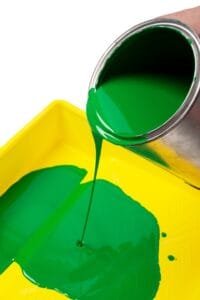Introduction to Eco-Friendly Home Paints
Eco-friendly home paints are designed to minimize environmental impact while providing quality finishes for residential spaces. Unlike conventional paints, which often contain harmful volatile organic compounds (VOCs) and synthetic chemicals, eco-friendly alternatives prioritize natural ingredients. These products offer safer options for homeowners, reducing both indoor air pollution and environmental degradation. The importance of sustainable practices in home improvement cannot be overstated, especially in today’s climate-conscious society.
As consumer awareness grows, the demand for environmentally-friendly products has surged. Homeowners are increasingly seeking paints that align with their values of sustainability and health. Eco-friendly home paints are available in various formulations, including water-based, natural, and organic options, catering to diverse aesthetic preferences and functional needs. The increasing popularity of these paints signifies a shift towards greener living, where choice plays a significant role in promoting eco-sustainability.
Moreover, manufacturers are responding to this demand by innovating their product lines, resulting in high-quality paints that rival traditional offerings. The advantages of using eco-friendly paints extend beyond aesthetics; they also encompass durability, ease of application, and lower toxicity levels. By opting for products like mithila home paint and other eco-friendly options, consumers can enhance their living spaces while contributing positively to the environment.
In conclusion, eco-friendly home paints represent a significant evolution in the home improvement industry. They not only reflect an enlightened consumer mindset but also embody a commitment to sustainable living that respects both personal health and the planet’s well-being. As enthusiasts of eco-friendly practices, homeowners can take pride in choosing innovative products that support a healthier future for themselves and the environment.

Types of Eco-Friendly Paints
In recent times, the demand for eco-friendly home paints has significantly increased, driven by a growing awareness of environmental issues and health concerns associated with traditional paint options. There are several categories of eco-friendly paints available, each with unique properties and advantages, catering to diverse needs and preferences.
One prominent category is water-based paints, which use water as a solvent rather than harmful organic solvents. These paints are known for their low levels of VOCs, making them less toxic and more environmentally friendly. Benefits of water-based paints include easy cleanup with water, quick drying times, and a variety of finishes. They are ideal for both interior and exterior applications, and are suitable for various surfaces, including walls and ceilings.
Another category encompasses natural paints, which are derived from biodegradable materials such as plant oils, proteins, and minerals. Natural paints are often free from synthetic chemicals, providing a healthier alternative for indoor environments. These paints not only minimize environmental impact but also contribute to better indoor air quality. They tend to have unique textures and finishes and are particularly popular among environmentally conscious homeowners seeking authentic aesthetics.
Additionally, low-VOC paints have gained traction in the eco-friendly market. They are formulated to contain significantly lower levels of volatile organic compounds compared to traditional paints. This characteristic contributes to reduced health risks during and after application. Low-VOC paints are versatile and suitable for a wide range of applications, from residential to commercial settings, making them an attractive option for those seeking a balance between performance and environmental responsibility.
By selecting any of these eco-friendly options, homeowners can ensure that their choice of mithila home paint not only enhances the aesthetics of their living spaces but also contributes positively to their health and the environment.

Benefits of Using Eco-Friendly Paints
Choosing eco-friendly paints for your home offers a plethora of advantages that extend beyond the immediate aesthetic appeal. One significant benefit lies in the environmental impact. Traditional paints often contain harmful chemicals, known as volatile organic compounds (VOCs), which can contribute to air pollution and the depletion of the ozone layer. In contrast, eco-friendly options such as mithila home paint are designed to minimize these pollutants and lessen the overall carbon footprint. By selecting sustainable paints, homeowners can play a vital role in protecting the environment while also supporting manufacturers dedicated to eco-conscious practices.
In addition to environmental advantages, eco-friendly paints also prioritize the health and well-being of occupants. Conventional paints expose individuals to potentially harmful substances that can lead to headaches, allergic reactions, and other health issues. On the other hand, mithila home paint and similar eco-friendly alternatives are formulated with non-toxic ingredients, making them safer for families, including children and pets. This aspect is particularly critical for those who may be sensitive to chemicals, as eco-friendly paints significantly reduce the risk of exposure to harmful substances.
Moreover, the aesthetic qualities of eco-friendly paints should not be overlooked. Many consumers are surprised to find that options like mithila home paint provide a vibrant range of colors and finishes, enabling homeowners to achieve their desired look without compromising on quality. Furthermore, these paints tend to have excellent durability, which can result in less frequent repaints and, consequently, less waste generated over time.
Another noteworthy advantage is the improved air quality that comes with using eco-friendly paints. Traditional paints can release toxins long after application, affecting indoor air quality. Eco-friendly paints, however, are formulated to emit fewer chemicals, promoting a healthier living environment. In summary, the benefits of eco-friendly paints encompass environmental preservation, enhanced occupant health, aesthetic versatility, and superior air quality, making them an ideal choice for conscientious homeowners.
How to Choose Eco-Friendly Paints
Selecting eco-friendly paints for your home is a crucial step towards reducing your environmental footprint while enhancing your living space. The first and foremost action is to read labels meticulously. Many paint manufacturers now provide detailed descriptions of their products, highlighting their eco-friendly properties. Look for paints that indicate low levels of volatile organic compounds (VOCs), as these compounds can contribute to air pollution and health issues.
Understanding certifications is another important aspect when choosing a sustainable paint. Several organizations, such as Green Seal, Energy Star, and the Forest Stewardship Council (FSC), provide certifications that reflect a product’s environmental standards. A certified product not only assures you of reduced emissions but also often incorporates sustainable sourcing practices. When you encounter a paint product, ensure it proudly displays one or more of these eco-certifications to verify its commitment to sustainability.
It is also essential to identify which harmful substances to avoid. Common harmful ingredients found in traditional paints include heavy metals such as lead and mercury, which can pose serious health risks. Additionally, some paints may contain toxic solvents and preservatives that can emit harmful fumes. By checking the ingredient list, you can avoid paints that contain these harmful components, thereby ensuring a safer environment for you and your family.
Finally, it is advisable to consider the long-term effects of the paint you choose. Mithila home paint, for example, offers a variety of eco-friendly options that not only meet aesthetic needs but also prioritize health and sustainability. When making your selection, take the time to research different brands and their commitment to using sustainable practices. In this way, you empower yourself to make informed decisions that benefit both your home and the planet.

Popular Brands of Eco-Friendly Paints
In the realm of sustainable living, choosing the right paint plays a pivotal role in maintaining both aesthetics and health. Several well-known brands specialize in eco-friendly paints, offering products that not only minimize environmental impact but also promote indoor air quality. Here are some prominent brands worth considering.
One notable brand is Earthborn, renowned for its natural paints that avoid the use of petroleum-based solvents. Earthborn’s range includes eco-friendly emulsions, finishes, and primers, all crafted from natural minerals and plant materials. Their commitment to sustainability is evident, as they prioritize low VOC content and recyclable packaging, making them a forefront player in the sustainability space.
Another key name is AFM Safecoat, which has gained popularity for its extensive line of no-VOC and low-VOC paints. Their products are specifically designed to be safe for sensitive individuals, and they are a preferred choice among those seeking to maintain healthy indoor environments. AFM Safecoat paints have been certified by environmental organizations, ensuring compliance with strict safety standards.
Benjamin Moore also deserves mention for their eco-friendly offerings such as the Regal Select line, which includes products that are certified by Green Seal. With a mix of performance and sustainability, Benjamin Moore focuses on reducing environmental impact while providing a variety of colors that cater to diverse tastes.
Lastly, Valspar has made strides in eco-friendly paint with its Signature line, featuring paints that are free of harmful chemicals and offer good coverage. Their commitment to sustainability translates into improved indoor air quality and reduced environmental damage.
These brands represent a starting point for anyone looking to use eco-friendly options like mithila home paint in their projects. The selection of sustainable paints continues to grow, enabling consumers to not only beautify their homes but also support the environment.

Application Tips for Eco-Friendly Paints
Applying eco-friendly home paint effectively requires careful preparation and the right techniques. Begin by ensuring the surface you intend to paint is clean and dry. Remove any dirt, grease, or old paint from the area using a gentle cleaner and sandpaper if necessary. This step is crucial, as a clean surface promotes better adhesion and minimizes the risk of peeling or chipping in the future.
Once the surface is prepared, make sure to use high-quality tools specifically designed for eco-friendly paints. Opt for synthetic or natural bristle brushes, as they work well with low-VOC and water-based paints. For larger areas, rollers can provide a smooth finish and save time. If employing a spray technique, consider using an airless sprayer that allows for even distribution while reducing overspray.
Next, consider the application techniques you choose. It is advisable to apply the mithila home paint in thin, even coats rather than thick ones. Allowing each coat to dry completely before applying the next ensures better adhesion and enhances the final appearance. Pay attention to the manufacturer’s guidelines, which often recommend drying times and the number of coats needed for optimal results.
Incorporating trending application techniques, such as the “cutting in” method can aid in achieving crisp lines where walls meet ceilings or trim. Use painter’s tape to ensure clean edges, but remove it while the paint is still slightly wet to prevent peeling. Lastly, be mindful of environmental factors such as temperature and humidity, as they can affect the drying time and finish of your eco-friendly paints.
Implementing these best practices will help you maximize the effectiveness of your eco-friendly home paint, ensuring a beautiful and sustainable finish that you can enjoy for years to come.
Cost Comparison: Eco-Friendly vs. Traditional Paints
When considering the renovation of a living space, one of the key factors homeowners encounter is the cost of paints. Specifically, the choice between eco-friendly home paints, such as mithila home paint, and traditional paints is crucial. Initially, eco-friendly options may present a higher price point; however, it is essential to delve deeper into the overall value offered by these paints. Traditional paints often come at a lower upfront cost but may not provide the same level of performance or safety.
Eco-friendly paints, including various formulations like mithila home paint, are typically made from natural, renewable resources that lessen the impact on the environment. While they might be priced higher than their conventional counterparts, the benefits surpass mere financial expenditure. As the longevity of paint can significantly influence expense, eco-friendly options often boast a more durable finish which can outlast traditional paints. Their superior quality may lead to reduced maintenance and repainting frequency, generating long-term savings for homeowners. Thus, although the initial investment may be steeper, the life expectancy of these environmentally conscious paints often compensates for the higher purchase price.
Moreover, traditional paints often contain volatile organic compounds (VOCs) that can harm indoor air quality and trigger health issues, potentially leading to additional healthcare costs for sensitive individuals. In contrast, mithila home paint contains minimal or no VOCs, promoting a healthier living environment and reducing the likelihood of health-related expenses. Therefore, when assessing the total cost of ownership, eco-friendly paints present a compelling case against traditional options. By weighing initial costs, health implications, and long-term performance, consumers can make informed choices that align with their budget and values regarding sustainability and safety.
Case Studies: Success Stories with Eco-Friendly Paints
The transition to eco-friendly home paints has been a transformative journey for numerous homeowners who sought healthier living environments while minimizing their ecological footprints. One compelling case is that of the Johnson family, who recently renovated their residence using mithila home paint. Concerned about toxic emissions from traditional paints, they opted for a plant-based alternative that not only met their aesthetic preferences but also prioritized their family’s health.
After applying the eco-friendly paint, the Johnsons reported a significant reduction in unpleasant odors commonly associated with conventional paints. Additionally, the breathable nature of mithila home paint improved indoor air quality, allowing their family to enjoy a safer environment, particularly for their young children. The family emphasized that not only did the paint enhance their home’s aesthetics with its vibrant colors, but it also fostered a comforting atmosphere free from harmful chemicals.
Another inspiring story comes from a community initiative led by a local nonprofit, aimed at revitalizing public spaces using eco-friendly solutions. They utilized eco-conscious paints to restore a community park’s playground. The success of this project highlighted the durability and vibrant results achievable with mithila home paint. Residents praised the initiative for its commitment to sustainability, stating that the newly painted playground not only rejuvenated the area but also encouraged families to spend more time outdoors in a toxin-free environment.
Furthermore, testimonials from homeowners who have adopted eco-friendly paints consistently depict an overwhelming sense of satisfaction. Many express their priorities for sustainable living, highlighting how mithila home paint contributed to their overall wellness and reduced their environmental impact. The cumulative evidence from these case studies demonstrates that opting for eco-friendly home paints is not merely a trend but a substantial commitment to both personal health and planetary well-being.
Future Trends in Eco-Friendly Paints
The eco-friendly paint industry is rapidly evolving, driven by advancements in sustainability and consumer preferences. A significant trend is the increasing demand for high-performance products that are also environmentally responsible. Manufacturers are responding by developing paints that not only minimize ecological impact but also provide superior durability and application characteristics. Innovations such as low-VOC (volatile organic compounds) formulas have become commonplace, appealing to health-conscious consumers who seek safer indoor environments.
Another important trend is the shift towards bio-based and organic materials. Companies are exploring alternatives derived from natural sources, such as plant oils and minerals, which reduce dependency on petrochemicals. This shift is not just about environmental impact; it also reflects a growing consumer interest in products that promote health and well-being. Paints that leverage natural ingredients, such as those inspired by traditional mithila home paint techniques, contribute to a holistic approach to home aesthetics and environmental stewardship.
Technological innovations are playing a crucial role in shaping the future landscape of eco-friendly paints. Smart technology integration, such as self-cleaning and air-purifying features, is being introduced into paint formulations. These advancements not only enhance the functionality of paints but also align with modern consumers’ preferences for products that contribute positively to their living spaces. Furthermore, digital color matching tools are making it easier than ever for consumers to achieve their desired look while ensuring they select eco-friendly options.
As we continue to observe these trends, the eco-friendly paint market is poised for significant growth. Consumer preferences are shifting towards sustainable solutions, and companies that can innovate while maintaining environmental consciousness are likely to thrive. The future of eco-friendly paints promises a blend of aesthetics, durability, and sustainability that caters to both individual and environmental needs. The rise of eco-conscious choices, such as mithila home paint, points towards a more sustainable and responsible approach to home decor.

